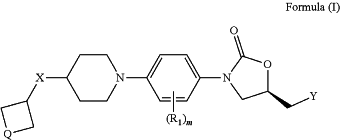| CPC A61K 31/438 (2013.01) [A61K 31/133 (2013.01); A61K 31/4409 (2013.01); A61K 31/454 (2013.01); A61K 31/496 (2013.01); A61K 31/4965 (2013.01); A61K 31/5383 (2013.01); A61K 31/606 (2013.01); A61K 31/7036 (2013.01); A61P 31/04 (2018.01); C07D 413/14 (2013.01); C07D 491/107 (2013.01); C07D 495/10 (2013.01)] | 6 Claims |
|
1. A compound of general formula (I),
 or a pharmaceutically acceptable salt thereof, wherein, X is either absent or a bond;
whenever X is absent, the four membered ring is directly attached to the 6-membered piperidine ring forming spirocyclic system with the spiro carbon at position 4 of the piperidine ring and Q being beta to the spiro carbon; Q is either O or S(O)p; p=0-2 integer; Y is OH, NR2R3, or NHC(O)R4; R1 is selected from H, F, Cl, CH3, CN and OCH3; m=1-4 integer; R2 and R3 are independently selected from H, (C1-C6)alkyl, (C3-C6)cycloalkyl, aryl, heterocyclyl and heteroaryl each of which may be further optionally substituted; or Rz and R3 are taken together with the nitrogen to which they are attached to form a 4- to 8-membered heterocyclyl or heteroaryl with 1 to 3 additional heteroatoms selected from O, S, or N, which heterocyclyl or heteroaryl may be further be optionally substituted; R4 is independently selected from (C1-C6)alkyl, (C3-C6)cycloalkyl, aryl, heteroaryl and (C1-C6)alkoxy, each of which is optionally substituted; substitutions are selected from halo, hydroxyl, (C1-C6)alkyl, (C1-C6)alkoxy, (C1-C6)acyloxy, haloalkyl, NO2, CN and NH2.
|